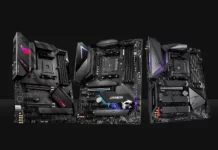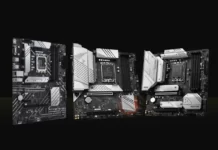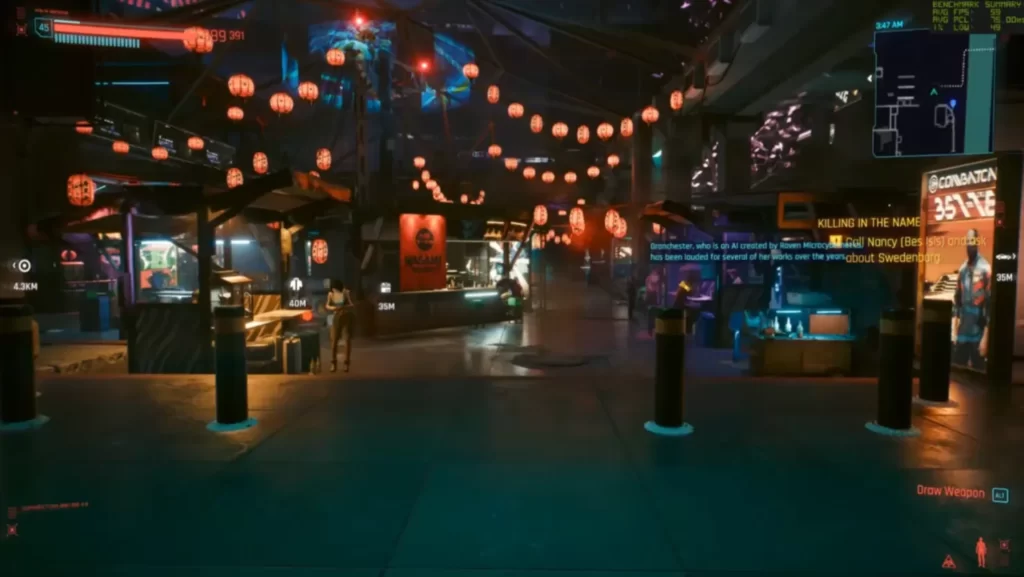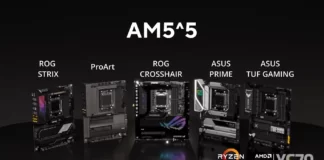In a quick gameplay demo with Cyberpunk 2077 & DLSS 3, NVIDIA’s top-tier GeForce RTX 4090 graphics card displayed some impressive numbers.
The NVIDIA GeForce RTX 4090 Founders Edition graphics card, which we thoroughly reviewed here, was used in the demonstration. Utilizing Ultra Ray Tracing and Psycho parameters. However, the card ran Cyberpunk 2077 at 1440p when connected with an Intel Core i9-12900K computer. Despite DLSS and Reflex, the game operates at its native resolution at an overall frame rate of 59 FPS, with a delay of 72–75 ms.
The GPU was operating at over 2.8 GHz at these parameters, ranging from approximately 2810-2850 MHz, while at 100%. The temps remained constant at 50 to 55 C. This signifies an increase of 13% (up to 330 MHz) over the standard peak clock of 2520 MHz, and what’s astounding is that no overclocking was done! All of this was going on at stock. Other games provide even faster clock rates than this one. Since then, it has been claimed that the card can be overclocked to operate above 3 GHz.
However, the efficiency of DLSS 3 must now be discussed. Performance and parameters will differ in the game’s ultimate edition because it used a pre-release edition of DLSS 3. The DLSS Frame Generation setting becomes active as quickly as the DLSS 3 setting is turned on. We once more saw full GPU use with over 2.8 GHz rates when using the Quality option. However, the temperatures were more in the range of 50C than 55C.
With DLSS 3 activated and an average delay of 53.00ms. On average, the NVIDIA GeForce RTX 4090’s efficiency increased to 170 frames per second (FPS) (119 FPS on 1% Lows). That represents a 2x increase in FPS and a 30% decrease in latency compared to DLSS deactivated.
NVIDIA GeForce RTX 4090 in Cyberpunk 2077 (DLSS 3 Disabled):

NVIDIA GeForce RTX 4090 in Cyberpunk 2077 (DLSS 3 Enabled):
But it’s only some; NVIDIA also gave the power estimates with DLSS turned on and off using the most recent PCAT tool. So, it supports the PCIe 5.0 16-Pin (12VPHWR) power connection. The NVIDIA GeForce RTX 4090 graphics card used 461 Watts with DLSS 3 deactivated and had a performance per watt (Frames/Joule) of 0.135 points. When DLSS 3 was activated, the GPU’s power decreased to 348W, a 25% decrease. Additionally, this resulted in a 0.513 perf per unit gain, a 3.8x boost.
NVIDIA GeForce RTX 4090 Cyberpunk 2077 Demo
| CYBERPUNK 2077 1440P (MAX SETTINGS + ULTRA RT + PSYCHO) | NVIDIA GEFORCE RTX 4090 | NVIDIA GEFORCE RTX 4090 | NVIDIA GEFORCE RTX 3090 TI | NVIDIA GEFORCE RTX 3090 TI |
|---|---|---|---|---|
| DLSS 3 | Disabled (Native) | Enabled (Quality) | Disabled (Native) | Enabled (Quality DLSS 2) |
| FPS (Average) | 59.9 | 170.7 | 35.8 | 61.9 |
| FPS (1% Lows) | 49.3 | 119.6 | – | – |
| FPS (Min) | 40.6 | 91.2 | – | – |
| Latency (Average) | 75.4ms | 53.5ms | – | – |
| GPU Clock | 2800-2850 MHz (Stock) | 2800-2850 MHz (Stock) | 2000-2050 MHz | 2000-2050 MHz |
| GPU Temps | 50-57C | 50-53C | 70-75C | 70-75C |
| GPU Power | 461.3W | 348.9W | 454.2W | 409.2W |
| PCAT Perf/Watt (FPS/Joule) | 0.135 | 0.513 | 0.079 | 0.152 |
Wccftech has added performance data from our GeForce RTX 3090 Ti with and without DLSS. Because we are using a bespoke MSI SUPRIM X design with a higher factory OC, performance should be marginally superior to the FE variant. Under the same conditions and scene, the card at stock achieved an average frame rate of 37.2 at native 1440p. The card used 452W of power and was operating at 75C. We observed a rise to 61 FPS (+64% increase), and a reduction in power consumption to 409W (-10%) with DLSS 2 Quality enabled. The outcome is listed below.
Ultra Quality + Psycho RT for Cyberpunk 2077 (Native 1440p):
- RTX 3090 TI SUPRIM X from MSI (Stock Native 1440p) – 37 FPS, 455 W of power, and 75 C
- RTX 4090 FE from NVIDIA (Stock Native 1440p) – 60 FPS, 461 W of power, and 55 C
- RTX 4090 is +62% faster than RTX 3090 Ti.
Cyberpunk 2077 Ultra Quality + Psycho RT (DLSS 1440p):
- RTX 3090 Ti SUPRIM X from MSI (DLSS 2 1440p) -61 FPS, 409 W of power, and 74 C
- RTX 4090 FE from NVIDIA (DLSS 3 1440p) – 170 FPS, 348 W, and 50 C
- RTX 4090 is +178% faster than RTX 3090 Ti.
The power numbers are a seriously big deal, and one reason this may be happening is that the load of the FP32 cores is moved to the tensor cores that run the DLSS algorithms. These cores are specialized at these talks, and rather than brute-forcing the whole GPU, which results in a higher power draw, the tensor cores can process the data much faster and more efficiently while leading to lower power consumption. DLSS 3 can be a game changer in power efficiency and performance efficiency, and we can’t wait to test this out for ourselves when we get our review samples.
News Source:- wccftech.com




































